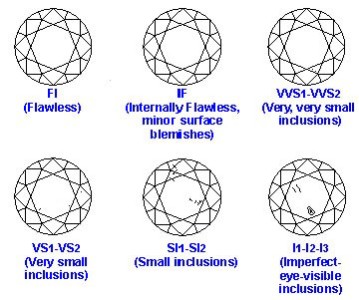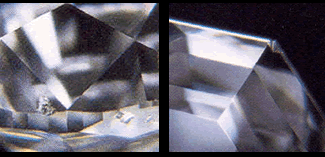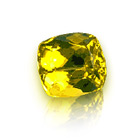While Diamond Source of Virginia does not own inventory, we do offer to broker diamonds and jewelry for clients who need to sell items. We only broker items of high quality that are priced as exceptional values. As a result, these are often the best values on the market.
If you are looking for a special value or have a diamond you need to sell, check out our Special Offers page to see what we have to offer today.
Check out the special offers page
DIAMOND SHOPPER MISTAKES: GET THE CLARITY YOU NEED
Every day we receive request for diamonds with Internally Flawless, VVS1 or VVS2 clarity. We immediately ask if the shopper really requires that high of clarity grade or if they simply want a diamond that is very clean to the eye.
For brilliant cut diamonds (rounds, ovals, princess, radiants, etc) most SI1 clarity diamonds are clean to the eye. For step cut shapes (emerald cuts, Asschers, etc) that have few facets and are very transparent, we recommend at least VS2 clarity to ensure the diamond is clean to the eye.
 All diamonds have inclusions in them. The only difference between the clarity grades is how visible they are under the microscope. With IF clarity, the inclusions are not visible under 10x magnification. With VVS1 and VVS2 clarity, it takes about 30 minutes with a microscope at 10x or higher magnification to find the pinpoint inclusion. With VS1 clarity it takes about 10 minutes with 10x or higher magnification to find the inclusion and with VS2 clarity it only takes several minutes to find the inclusions. Of course all of these are very clean to the eye. Higher clarity grades add nothing to the beauty of the diamond because once a diamond is clean to the eye, higher clarity grades have no impact on appearance; they are simply rarer and more expensive.
All diamonds have inclusions in them. The only difference between the clarity grades is how visible they are under the microscope. With IF clarity, the inclusions are not visible under 10x magnification. With VVS1 and VVS2 clarity, it takes about 30 minutes with a microscope at 10x or higher magnification to find the pinpoint inclusion. With VS1 clarity it takes about 10 minutes with 10x or higher magnification to find the inclusion and with VS2 clarity it only takes several minutes to find the inclusions. Of course all of these are very clean to the eye. Higher clarity grades add nothing to the beauty of the diamond because once a diamond is clean to the eye, higher clarity grades have no impact on appearance; they are simply rarer and more expensive.
Of course we are happy to find you any type of diamond our clients seek but we try to make sure they understand that very high clarity grades (VS1, VVS2, VVS1 and IF) are simply grades on the certification and do not impact the appearance and beauty of the diamond. Since there are relatively few diamonds with these high clarity grades, it becomes harder to find those with exceptional cut which is the most important factor in a diamond’s beauty. Often cutters have to cut extra facets and take other steps that sacrifice great cut in order to cut away the microscopic inclusions to get the unusually high clarity grades. By considering lower clarity grades that are clean to the eye, shoppers can not only get more diamond for their money but can also increase the opportunity to find one with really great cut that will be even more beautiful.
Discover more shopping advice secrets
CLEANING DIAMONDS
Diamonds, like anything else, get smudged, soiled and dusty. Lotions, powders, soaps–even the natural oils from your skin will create a film on diamonds, which will reduce their brilliance. In addition, chemicals in the air will oxidize or discolor the mountings. Keeping your jewelry clean will maximize its brilliance. Here are four ways you can clean your diamonds:
Detergent Bath: Prepare a small bowl of warm suds using any mild household liquid detergent (be sure not to use any cleaners containing chlorine). Brush the jewelry with a soft brush until you have created a lather around it. With the jewelry on a plastic or metal strainer, rinse off with warm water (be sure not to clean your jewelry over the drain!) Pat your jewelry dry with a soft, lint-free cloth.
Cold Water Soak: Make a solution of 4 parts cold-water and 1 part very mild dishwashing detergent. Soak the pieces for several minutes. Lift out and tap gently around all sides of the mounting with a soft brush. Rinse the pieces in the solution once more and drain on tissue paper.
Quick-Dip Method: Buy one of the brand name liquid jewelry cleaners, choosing the one that is best for the kind of stones and metals in your jewelry. Read the label carefully and follow the instructions. Do not touch your clean diamonds with your fingers, as the oils from your hands will leave a film on the stone.
The Ultrasonic Cleaner: There are many types of these small machines available to the public today. They will clean any piece of jewelry that can be soaked in a liquid within a matter of minutes. These machines often have a metal cup, which is filled with water and detergent. When the machine is turned on, high-frequency turbulence is created. Avoid putting emeralds and pearls in ultrasonic cleaners.
JENNIFER LOPEZ DIAMOND FOR SALE
The ring that launched a million Bennifer references was put back on the market for sale, just in time for Valentine’s Day. The 6.1-carat pink diamond purchased for Jennifer Lopez by Ben Affleck, has been “reacquired” by Harry Winston, a spokesperson for the jeweler confirmed.
The rock, once a tabloid fixture, vanished from Lopez’s left ring finger and the public eye after Lopez and Affleck’s lavish wedding plans famously went bust in January 2004. Affleck, meanwhile, went out and got himself another Jennifer–namely, his Daredevil costar, Jennifer Garner, with whom he’s been linked for several months.
Now, the ring that once symbolized the love affair that was Bennifer has resurfaced to try its luck on the next high-maintenance hand that desires it. The sparkler reportedly set Affleck back $1.2 million when he purchased it in 2002. Per, Harry Winston, its current price tag is available only to serious bidders.
INCLUSIONS & BLEMISHES: NATURALS AND INDENTED NATURALS
 A “natural” is simply part of the original “skin” of the diamond that was left on the diamond instead of being removed during the cutting and polishing process. The original surface of the diamond’s skin might have growth markings that look like triangles (trigons) or parallel grooves. Most often a natural is left on a diamond because removing it would reduce the weight of the finished diamond unnecessarily. Most naturals are located along the girdle edge of a diamond although some are also seen on other facets from time to time.
A “natural” is simply part of the original “skin” of the diamond that was left on the diamond instead of being removed during the cutting and polishing process. The original surface of the diamond’s skin might have growth markings that look like triangles (trigons) or parallel grooves. Most often a natural is left on a diamond because removing it would reduce the weight of the finished diamond unnecessarily. Most naturals are located along the girdle edge of a diamond although some are also seen on other facets from time to time.
Naturals located with the area of the girdle are looked upon as a minor blemish and have little effect on the diamond’s value. To view these naturals you must examine the diamond from the side. Naturals just below the girdle are the most common type of natural and can vary in size from microscopic to eye-visible. Most are not visible from the top.
An indented natural is a portion of the original rough diamond crystal surface, or skin, which dips below the polished diamond’s surface. Chips, cavities and indented naturals can be difficult to distinguish from each other even with 10X magnification.
CANADIAN DIAMOND PRODUCTION
 Canada’s first diamond mine, BHO Billiton’s Ekati, had its first full year of production in 1999 and provided $7 billion or 5.3 percent of the world’s diamond production at that time. In 2003, Rio Tinto’s Diavik Diamond Mine went into production and Canada contributed 11.2 million carats or 7.5 percent of the total world production. This made Canada the world’s third-largest producer of diamonds behind Botswana and Russia, moving ahead of South Africa and Angola.
Canada’s first diamond mine, BHO Billiton’s Ekati, had its first full year of production in 1999 and provided $7 billion or 5.3 percent of the world’s diamond production at that time. In 2003, Rio Tinto’s Diavik Diamond Mine went into production and Canada contributed 11.2 million carats or 7.5 percent of the total world production. This made Canada the world’s third-largest producer of diamonds behind Botswana and Russia, moving ahead of South Africa and Angola.
In 2006, the Jericho Diamond Project in the Canadian providence of Nunavut is schedule to begin full production. At that time Canadian diamond production is projected to be $10.5 billion or 11.6 percent of the world’s production
In 2007, Canadian diamond production will increase again when the De Beers Snap Lake Diamond Project goes into production. Canada will then provide close to $11 billion or 13.9 percent of the world’s total diamond production.
Despite this increase in diamond production, the projected demand for diamonds worldwide is expected to increase faster than supply. Future newsletters will be discussing the impact this is having now and in the future on diamond prices.
GEMSTONES: BERYL
The name is from ancient Greek, beryllos, and means “precious blue-green color”. Beryl is a 7.5 to 8 on the Mohs scale and is found in Colombia, Africa, Brazil, Russia, Pakistan, and California.
Legend says that Beryl was used to ward off demons and evil spirits. Ancient literature notes that Pliny used powdered beryl to cure eye injuries. It is said to protect travelers from danger and to treat disorders of the heart and spine. Other legends about Beryl indicate it was used to promote cheerfulness and marital love, to retard laziness, and maintain youthfulness. Golden beryl is said to make one sympathetic and increase sincerity.
Beryl occurs in a variety of colors. All transparent varieties are used as gemstones. Pure beryl is colorless; traces of different impurities are responsible for the great color range in this gemstone. Each color variety has a distinct name:
Emerald, the green variety, is the most popular green gemstone and is one of the most valuable of gems.
Aquamarine is a light blue to blue-green variety.
Morganite, the pink to purple variety, is usually only lightly tinted. The color of pale stones can be intensified by heat-treatment. Morganite is sometimes also called “pink beryl”.
 Heliodor is the variety including all yellow, yellow-green, orange, and brown beryls. Golden beryl, sometimes also called “heliodorite”, is a variety of heliodor with a golden yellow color. The terms heliodor and golden beryl are often confused with each other, and some dealers and references incorrectly mix up heliodor and golden beryl.
Heliodor is the variety including all yellow, yellow-green, orange, and brown beryls. Golden beryl, sometimes also called “heliodorite”, is a variety of heliodor with a golden yellow color. The terms heliodor and golden beryl are often confused with each other, and some dealers and references incorrectly mix up heliodor and golden beryl.
Goshenite, the colorless variety of beryl, is often used as a replacement for more valuable colorless gems. Goshenite may also be coated with a green foil to resemble emerald, as its physical properties are identical to emerald.
Peach beryl, also known as “champagne beryl”, is a variety of morganite with an orange-pink color.
Green beryl, the light green variety of beryl, should not be mistaken for emerald, which occurs in a much darker green. Green beryl is usually heat-treated to form deeply colored aquamarines.
Bixbite is a strawberry-red variety of morganite, with a brownish hue.
Red beryl is a rare, deep red variety found in only one place in the world.
Blue beryl is a dark blue variety, synthetically colored by irradiating light blue aquamarine.
Most of these variety names are universally used, but some, such as bixbite and blue beryl are not well-known. Gem beryls other than emerald and aquamarine may also be called “precious beryl”. Internal flaws in beryl gems can be masked by treating the stone with oil. Unscrupulous dealers will often apply this treatment to a stone without informing the buyer.
All the varieties are faceted into various gem cuts, and some stones display asterism and cat’s eye effect when cut and polished into cabochons. Ornamental figures are sometimes carved from massive chunks of transparent beryl, usually from morganite and heliodor. Perfect, transparent, six-sided crystals are occasionally worn as necklace pendants in an uncut state.
